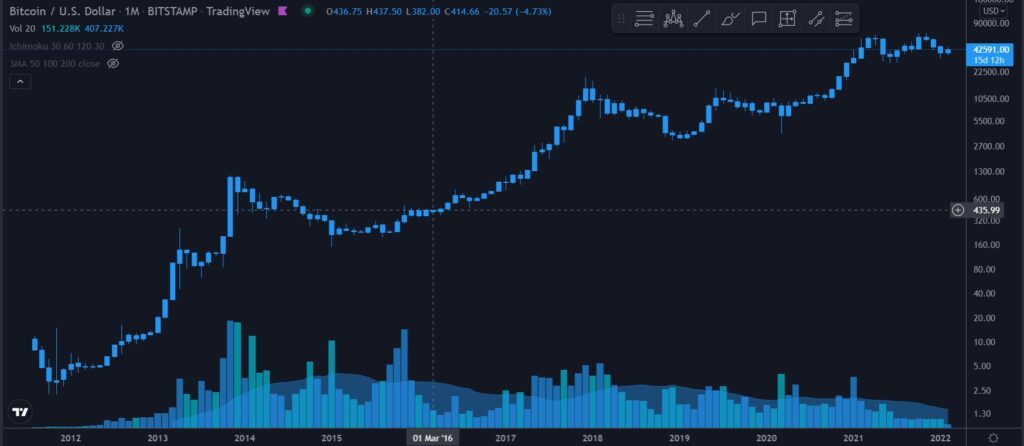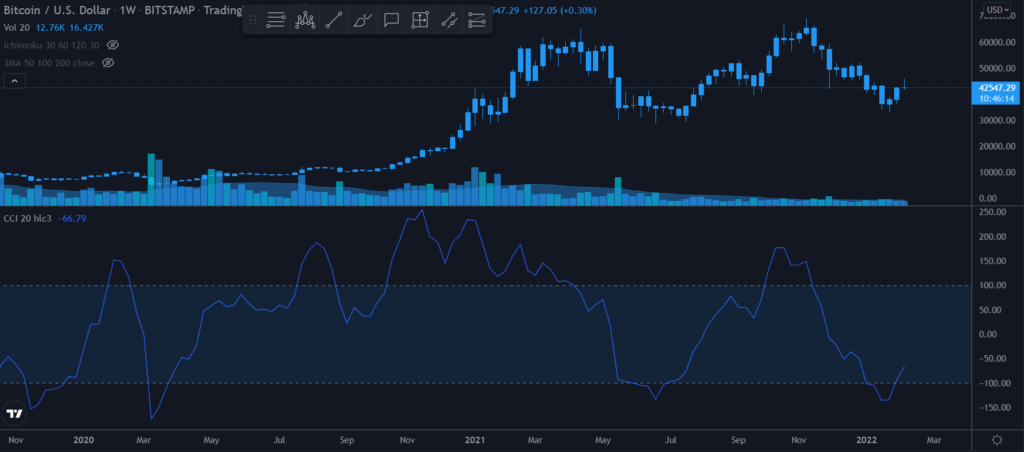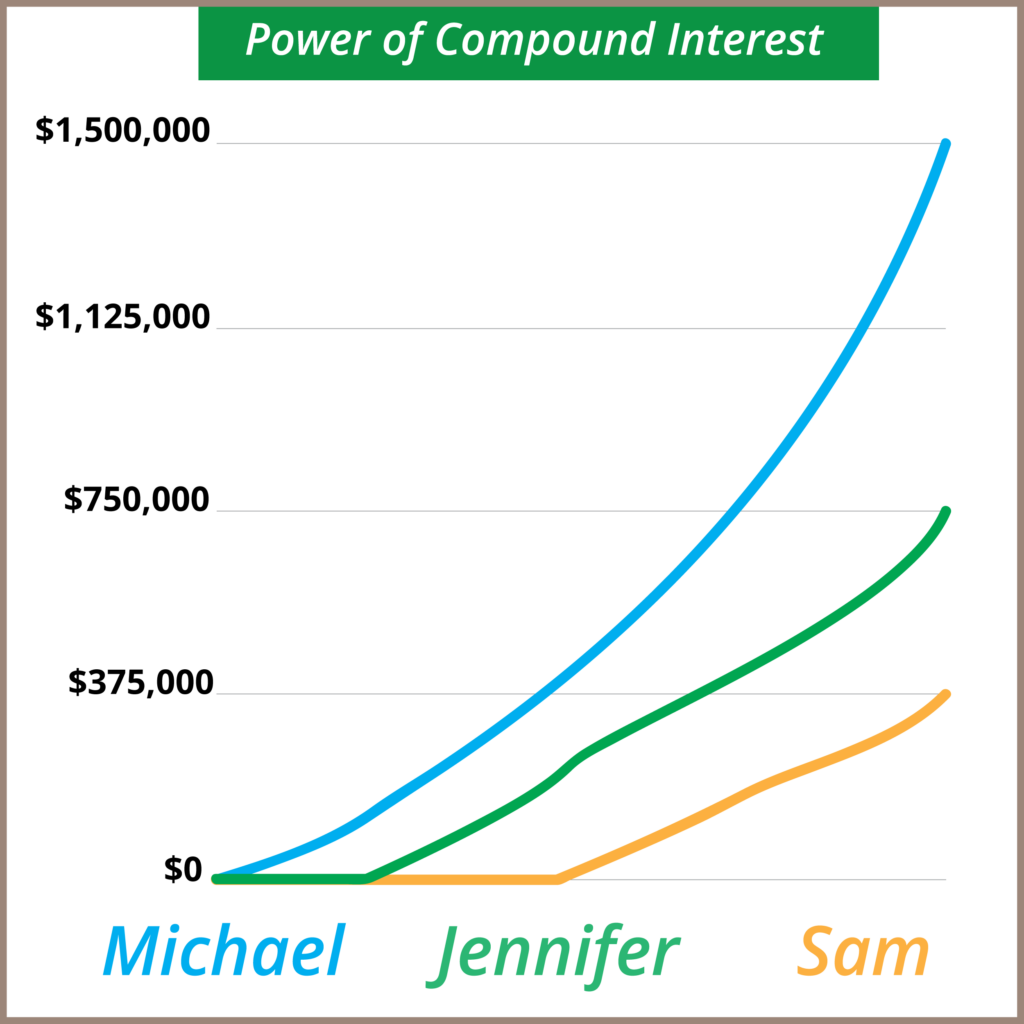In this article, we use examples of some of the important cryptocurrency milestones of 2021, in order to preface and help explain the key crypto market trends for 2022 that we expect to see great development in. This will also include how cryptocurrency, and the DeFi community as a whole, has already surpassed simply ‘making a mark’ with the wider population and brand marketing.
The volatility of the cryptocurrency market ran high in 2021. The year had begun with a strong rally, which pushed the exchange rate to an all-time high, for some tokens, in the spring. Following this, in May the crypto market collapsed, throughout the summer it then tried to recover. Then, in November, Bitcoin reached a new all-time high. Unfortunately, this then turned around in December when a bear market ensued, despite previous predictions showing that it should have continued to rise.
Despite the decentralized finance (DeFi) sector’s development really picking up pace as early as 2020, adoption and innovation really started to pick up by 2021.
New DeFi applications (DApps) and services have allowed crypto users to begin to use their tokens in many diversified ways, such as taking out loans and earning returns using their coins. Non-Fungible Tokens (NFTs) have swarmed both the online marketplaces that were curated purely for digital art collections, as well as traditional auction houses.
In November, the total crypto market capitalization reached $3 trillion. This is when Bitcoin and Ether reached their peak, which later slipped back to $2.5 trillion in December.
Key trends and forecasts for 2022
High volatility can sometimes make it more difficult to accurately predict crypto prices, but there are clear trends that affect the acceptance of cryptocurrencies and tokens, which in turn will effectually help to determine the direction that the prices will take.
Here are seven key topics that could dominate our cryptocurrency markets in the duration of 2022, building on developments that we had seen in 2021.
1. Web3 brings decentralization of the Internet
For those that may not know, Web3 refers to an ecosystem of next-generation Internet applications that will run via blockchains.
The first version of the Internet focused on static content, and the current version of the World Wide Web (Web2) is dominated by large companies that use the personal data of users in order to shape experiences for personalized advertising. However, Web3 is said to promise to return an individual’s control over their own personal data through decentralized applications. These will reward users’ attention with cryptocurrency tokens.

2. Financial service providers build ‘on-chain’
DeFi is one of the first decentralized applications to get off to a great start this year, as the blockchain infrastructure is well-suited for processing financial transactions. Several cross-border payment service providers, especially in developing countries, began switching their transfer services to blockchain platforms in 2021, and this trend is set to continue throughout the rest of 2022.
3. Tokenization of NFTs and real assets
As most will already know, in 2021, Collectible NFTs became one of the hottest topics and gained a lot of popularity very quickly. Collections of these digital arts, such as CryptoPunks and Bored Ape Yacht Club, have sold at neck-breaking prices. For example, Bored Ape #8585 at current is officially the most expensive of the BAYC collection, selling for $2.7M, and was sold via the digital art platform OpenSea.
Some of the most popular NFT collections add unique features through airdrops and additional token sales that allow users to further develop their artwork and build communities around them through various meetups, as well as social media and discord groups.

As the value of some NFT collections skyrocketed in secondary resale markets, they have also become popular with investors looking to profit from future sales.
It is even thought that it will also be possible to use NFTs in order to tokenize real assets (such as real estate or physical works of art) for sale, purchase, or to use as collateral for loans.
4. Multi-chain scaling
Multi-chain scaling will greatly promote the widespread adoption of NFTs. Most blockchains are independent networks designed to serve specific network uses. However, as the spread of blockchains increases, there is a growing need for different chains to work in tandem, i.e. interoperability.
There are already many blockchain interoperability projects (such as Matic and Polygon, or Polkadot and Cosmos) that work on ways to improve the communicative ability of different chains. Inter-chain functionality will allow users to transfer assets between various chains.
Further to this, due to Ethereum blockchain transaction fees remaining high, some applications and NFT developers are moving towards alternative blockchains such as Solana and Avalanche. However, with the emergence of Layer 2 solutions on the Ethereum blockchain, Ethereum continues to remain the dominant platform for smart contracts.
5. Play-to-earn increases among crypto games
Video game cryptocurrencies such as AXS and SLP (Axie Infinity), SAND (Sandbox) and ILV (Illuvium) skyrocketed in 2021. This created a huge amount of liquidity. In play-to-earn NFT-based games, players can use NFT-based characters to acquire cryptocurrency tokens as rewards in-game, which can then be converted into fiat currencies via exchanges.
As such, games like Alien Worlds, Axie Infinity, Sandbox and Splinterlands all became very popular in 2021 and in 2022 new games such as Illuvium, MicroPets and Star Atlas will have their official launches respectively.
As the number of players in these games gradually increases, in turn, the demand for tokens used to buy, sell and search for NFT characters will increase also. This in itself will support the rise in stock prices. The continuing development of the metaverse in 2022 will also increase the popularity of unique metaverses within games.
6. The Rise of the Metaverse
It wouldn’t be too farfetched to ponder the “Would the next ‘big’ cryptocurrency in 2022 be a metaverse coin?”
In 2021, technology companies and big-name brands had already begun to enter the world of the metaverse. For example, Facebook had announced in October that it was changing its company name to Meta, in reference to the metaverse. Then, in November, the government of Barbados made it the first country to establish a metaverse embassy in the virtual world of Decentraland.
Furthermore, MetaverseGroup.com – a vertically integrated real estate firm and a subsidiary of Tokens.com – has purchased $2.4 million worth of real estate in Decentraland. This was the largest metaverse land purchase to date and they aim to develop digital fashion shows and various dealerships here.
The trend around the metaverse could really intensify further in 2022. For example, Microsoft plans to introduce a workplace service, Mesh, as part of its Teams software. VR headsets will allow users to control their avatar and how they interact during the time they spend in the Metaverse. Games like Fortnite and Roblox have also evolved into virtual worlds where users can interact with each other in the digital space while playing.

Different brands also now have new and unique opportunities to expand their advertising activities which the Metaverse has afforded them. Nike, for example, has acquired the virtual fashion platform RTFKT, which was originally formed by Benoit Pagotto, Chris Le and Steven Vasilev in 2020. Also, Ralph Lauren launched a digital collection on the Roblox platform.
Prices of metaverse-related cryptocurrencies such as Decentraland MANA, THETA, ENJ, AXS and SAND rose nicely at the end of November, whilst high-market-capitalized coins, such as Bitcoin and Ether, were losing value.
7. Layer 2 networks accelerate Layer 1 blockchains
Layer 1 blockchain networks provide the infrastructure on which other networks, protocols, and applications can build. These blockchains include Ethereum, Solana, and Algorand. Layer 1 networks use native cryptocurrencies for transactions, increasing liquidity as their use increases. The different consensus mechanisms used by Layer 1 networks have varying levels of security, speed, and decentralization.
As we mentioned, Layer 2 networks build on this, improving the functionality that is offered by increasing speed, reducing fees, and enhancing security measures. For example, using a Layer 2 network like Polygon helps developers reduce transaction fees and latency on the Layer 1 Ethereum network.
Layer 2 networks, such as Polygon, Lightning Network, and Starknet, use different scaling solutions. An example of such a solution would be zero-knowledge (ZK) rollups. These use a side block-chain to initiate transactions, this chain would then send these transactions, in batches, to the main blockchain in order to increase efficiency. Because of this, the value of cryptocurrencies of Layer 2 networks using ZK rollups is expected to increase greatly throughout 2022.
Buy cryptocurrency quickly and easily in as little as 10 minutes.
read more about bitcoin’s history here

























